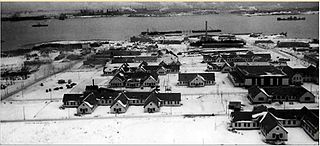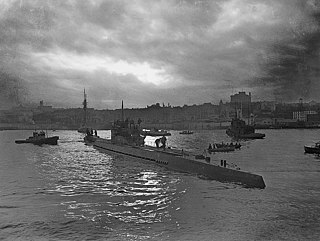
Cape Breton Island is a rugged and irregularly shaped island on the Atlantic coast of North America and part of the province of Nova Scotia, Canada.

Sydney is a former city and urban community on the east coast of Cape Breton Island in Nova Scotia, Canada within the Cape Breton Regional Municipality. Sydney was founded in 1785 by the British, was incorporated as a city in 1904, and dissolved on 1 August 1995, when it was amalgamated into the regional municipality.

Cabot Strait is a strait in eastern Canada approximately 110 kilometres wide between Cape Ray, Newfoundland and Cape North, Cape Breton Island. It is the widest of the three outlets for the Gulf of Saint Lawrence into the Atlantic Ocean, the others being the Strait of Belle Isle and Strait of Canso. It is named for the Italian explorer Giovanni Caboto.

Royal Canadian Navy base HMCS Protector, also known as the Point Edward Naval Base, was located next to Sydney Harbour, on Nova Scotia's Cape Breton Island. It was founded in 1940 and used by the navy during the Second World War. It was mainly used to provision, protect and repair the various merchant marine convoys to Quebec, Halifax, and the United Kingdom. It was a main combat zone during the Battle of the St. Lawrence and the more general Battle of the Atlantic. It continued to be utilized during the Cold War's early stages. It was decommissioned in 1964 and became the initial facility to house the Canadian Coast Guard College that same year. Currently, the Sydport Industrial Park utilizes the base's former piers and land.

Marine Atlantic Inc. is an independent Canadian federal Crown corporation which is mandated to operate ferry services between the provinces of Newfoundland and Labrador and Nova Scotia.

Channel-Port aux Basques is a town at the extreme southwestern tip of Newfoundland fronting on the western end of the Cabot Strait. A Marine Atlantic ferry terminal is located in the town which is the primary entry point onto the island of Newfoundland and the western terminus of the Newfoundland and Labrador Route 1 in the province. The town was incorporated in 1945 and its population in the 2021 census was 3,547.

The Newfoundland Railway was a narrow-gauge railway that operated on the island of Newfoundland from 1898 to 1988. With a total track length of 906 miles (1,458 km), it was the longest 3 ft 6 in narrow-gauge system in North America.

North Sydney is a former town and current community in Nova Scotia's Cape Breton Regional Municipality.

MV Joseph and Clara Smallwood was a Marine Atlantic passenger/vehicle ferry which operated between Newfoundland and Cape Breton Island in eastern Canada. She is named after former Newfoundland premier Joseph R. Smallwood and his wife Clara.

MV Caribou was a Marine Atlantic passenger/vehicle ferry which operated between the islands of Newfoundland and Cape Breton in eastern Canada.

JA Douglas McCurdy Sydney Airport is a regional airport located in Reserve Mines in the Canadian province of Nova Scotia. The airport serves the Cape Breton Regional Municipality (CBRM) and the surrounding areas of Cape Breton Island. McCurdy Sydney Airport has the distinction of being the oldest public airport in Nova Scotia, first licensed on August 3, 1929.

The Battle of the St. Lawrence involved marine and anti-submarine actions throughout the lower St. Lawrence River and the entire Gulf of Saint Lawrence, Strait of Belle Isle, Anticosti Island and Cabot Strait from May–October 1942, September 1943, and again in October–November 1944. During this time, German U-boats sank over 20 merchant ships and four Canadian warships. There were several near-shore actions involving the drop of German spies, or the attempted pickup of escaping prisoners of war. Despite the 23 ships lost, this battle marked a strategic victory for Canadian forces as ultimately they managed to disrupt U-boat activity, protect Canadian and Allied convoys, and intercept all attempted shore operations. This marked the first time that a foreign power had inflicted casualties in Canadian inland waters since the US incursions in the War of 1812.

German submarine U-69 was the first Type VIIC U-boat of the German Navy (Kriegsmarine) during World War II. This meant that compared to previous U-boats, she could travel further afield for longer, with a payload of fourteen torpedoes, an 8.8 cm (3.5 in) deck gun for smaller vessels and a flak gun for use against aircraft. U-69 was very successful, sinking over 72,000 gross register tons (GRT) of Allied shipping in a career lasting two years, making her one of the longest surviving, continuously serving, U-boats. Her most notable attack was on the civilian ferry SS Caribou, which sank off the coast of Newfoundland in October 1942, killing 137 men, women and children. She was rammed and sunk by HMS Fame on 17 February 1943.
The SC convoys were a series of North Atlantic convoys that ran during the battle of the Atlantic during World War II.

Western Local Escort Force (WLEF) referred to the organization of anti-submarine escorts for World War II trade convoys from North American port cities to the Western Ocean Meeting Point near Newfoundland where ships of the Mid-Ocean Escort Force (MOEF) assumed responsibility for safely delivering the convoys to the British Isles.

MV Patrick Morris was a train ferry regulated by the Canadian National Railway (CN) that sank on her run from North Sydney, Nova Scotia to Port aux Basques, Newfoundland during a storm in the early morning of 20 April 1970 while responding to a mayday call from the Newfoundland-based herring seiner FV Enterprise. The ship's Captain Roland Penney was given permission to leave North Sydney ahead of schedule to assist the distressed wood-hulled fishing vessel .No passengers were aboard Patrick Morris when she set sail shortly before midnight for the rescue mission on 19 April.
HMCS Grandmère was a Bangor-class minesweeper constructed for the Royal Canadian Navy during the Second World War. Entering service in 1941, the minesweeper took part in the Battle of the Atlantic and the Battle of the St. Lawrence before being taken out of service in 1945. The ship was sold for mercantile service following the war, first as the yacht Elda and then the cargo ship Jacks Bay. The ship was sold for scrap in 1968.

HMCS Burlington was a Bangor-class minesweeper constructed for the Royal Canadian Navy during the Second World War. The minesweeper entered service in 1941 and took part in the Battle of the Atlantic and the Battle of the St. Lawrence as a convoy escort. The ship was decommissioned in 1945 and sold in 1946. The vessel was broken up for scrap in 1946.
HMCS Georgian was a Bangor-class minesweeper constructed for the Royal Canadian Navy during the Second World War. Primarily used as a convoy escort in the Battle of the Atlantic and the Battle of the St. Lawrence, the minesweeper had the misfortune of mistakenly sinking the British submarine HMS P514 off the coast of Newfoundland. Georgian also saw service in European waters, taking part in the invasion of Normandy. Following the war the ship was discarded and sold for scrap.
Margaret Brooke, served as a nursing sister during the Second World War rising to the rank of lieutenant commander in the Royal Canadian Navy (RCN). Following the war, she earned a bachelor's degree and then a PhD in paleontology, serving as an instructor and researcher at the University of Saskatchewan's Department of Geological Sciences.


















